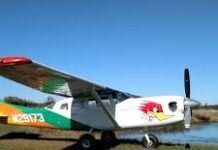Following its Chapter 11 bankruptcy filing, ICON Aircraft, known for its Icon A5 amphibious light sport aircraft, announced it has accepted an initial bid for the sale of its assets.
ICON announced the news in a May 3 press release revealing SG Investment America Inc. is the “stalking horse bidder,” tasked with setting the initial sale price.
“The decision to designate a stalking horse bidder underscores our commitment to ensuring the long-term viability of our business,” said Jerry Meyer, CEO of ICON Aircraft. “We believe that this proactive approach will help employees, partners, and customers have confidence in our ongoing operations, enabling the Company to achieve the best possible outcome.”
According to ICON, the stalking horse bidder’s proposal will be the starting point for competing offers throughout the bankruptcy sale proceedings, expected to extend until late May. ICON says the move is aimed at maximizing value for the company’s stakeholders including investors, vendors and members of the board.
Despite the financial challenges, ICON reaffirmed its commitment to delivering safe and innovative aircraft to its customers. Moreover, the company says it’s in close collaboration with the FAA to get production certification for its type certified ICON A5, allowing it to sell in international markets that don’t recognize the light sport aircraft category.




































These were great aircraft, at the original asking price or even $50,000 over that. And BEFORE the severe ownership contract restrictions and the life limited airframe.
It’s a shame. There was so much potential and excitement, and even some loopholes opened by the FAA regarding certification.
The poor accident history, in my opinion is not due to poor design, but rather poor driving.
If ICON goes under will the aviation world even notice?
ONLY if you were one of the over 200 SAPs who bought one or well over 1,000 people who put down money for one, Jethro.
If ya want to see what happens when reality meets the dreamers and schemers who come up with these cockamamie ideas, see: en.wikipedia.org/wiki/ICON_A5
The only thing remaining for these people to ‘invent’ is an eIconA5 (sigh!).
skimmed the wikipedia article. but what caught my eye was the last paragraph summary, noting that this is an airplane in a functional category of it’s own. Light sport with the emphasis on “sport” as in not travel, rather mostly for “buzzing around”; departing and arriving from the same spot. Perhaps GA misunderstood this and considered this a machine which could actually be used to go somewhere.
After 2 “bumps” in weight above the LSA category and being a complex aircraft, I can see how it can be considered to be in a “new category”. Perhaps it was the over-hype by Icon that lead to misunderstandings about what it’s limitations were?
And the ridiculous bump UP in price for what is — essentially — a $400K limited use jet ski.
I never get tired of being right.
I know… me tool…
Some of this stuff is just not that hard to figure out.
Like Jim Bede and his BD5; once the investment and pre-order cash runs out, the business is unsustainable.
GREAT reminder, Art. Worth noting, even Burt realized that about Jim Bede and left Newton for Mojave in the early 70’s. Shortly thereafter, the VeriViggen morphed into the VeriEze and … the rest is history. Many BD-5’s became wind direction indicators at GA airports, too. It’s one thing to be a good designer or great salesman; another to be able to deliver the goods at a price the market will bear. Bede was the former and not the latter.
And don’t forget Adam Aircraft, they actually got certified out here in Denver, sold about 6 planes and went belly up.
I should sit down and make a list of all the airplanes and vaporplanes and eAirplanes that have done that, Mike. The list would be voluminous. THAT is why my going in position on all of ’em is skepticism at the least if not pure contempt at best over false claims and all the rest.
This airplane had all the makings of something good UNTIL they found out what it’ll cost and sprang that on the unsuspecting placeholders and the market. It’s VERY doubtful that — even if the company is sold — it’ll ever be either successful OR profitable. Sad … but reality.
Spot on Art.
Your prophetic skills are amazing. After all, the odds of a new aircraft manufacturer going bankrupt is only about 98%.
It doesn’t matter if it’s a 172 clone or “revolutionary” it seems to me. I think the issue is just a dislike of anything that smells at all like hype among the pilot community and anything that is at all new among the FAA branches.
Personally, I’m all for new and innovative at other people’s expense. If there’s only a 2% chance of success, I’ll cheer on every one of them in hopes of a winner. I’d like to see the 172 go the way of the Stearman before I die.
If you just want more of the same, that’s fine, but you ought not be complaining about the status quo.
“The ICON A5 is built in the Company’s 300,000 sq. ft. state-of-the-art manufacturing facility in Tijuana, Mexico, which has become a center of excellence for composite manufacturing for aerospace, automotive, powersports, and many other high-tech industries. ICON’s facility, which employs nearly more than 250 technicians and engineers, produces between 4 to 5 airplanes each month with space to scale”.
If they can’t keep costs under control by using south of the border wages, where can you go to increase your margin?
Agree. Icon Aircraft Tijuana should consolidate in Mexico, if it survives Ch 11. Consolidating in Mexico could help Icon Aircraft after bankruptcy. Mexico offers lower costs and Icon already has a facility there. Learning curve is a done deal. There’s good cross border management. Location by California and the US is a plus. However, there are challenges like job losses in the US and ensuring quality control across borders. Carefully planned consolidation could benefit both Icon and Mexico’s aerospace industry. Mexicans would like that.
Proximity to California provides what advantage? It was only done there because this company was a silicon valley hype startup which didn’t care (much) about cost as it burned through investor money. Engineering can be done much less expensively elsewhere, manufacturing is already in Mexico and the new owners could be anywhere. SG is a French company with US HQ in NYC.
“Engineering can be done much less expensively elsewhere, manufacturing is already in Mexico and the new owners could be anywhere. SG is a French company with US HQ in NYC”
Reminds me of Boeing: Assembly is in Seattle, airframe is outsourced, engineering is outsourced, the current owners are everywhere (stock holders) US HQ in Chicago…
This is not a viable product IMHO.
All of the corporate big wigs were and are in California living the high life at the “little suckers” expense.
Yawn. ICON could have been so well off had they hired me as a consultant on day one.
I predicted this back in 2006 when they advertised an initial price of 125k per aircraft ! Then when they said they wanted to focus their advertising venues on boat and rv shows advertising how it “only” takes 20 hours to learn to fly one I knew this kind of thinking would doom them. I don’t know who their initial investors were but they had ridiculously deep pockets as I watched them buy up just about all the hangar space at the Tehachpi airport. I could go on and on………….
It was reported recently that Icon needed to sell 8 to 9 aircraft per month to breakeven, but sales have been 2 to 3 per month. What is the plan for a new investor to triple or quadruple sales?
The next wonder “aircraft” to watch is the Pivotal Helix. First presented to the public as the Blackfly at Airventure 2018, and showcased with lots of hype at every Airventure since, it was to be available for sale in 2019 at the price of an SUV. It was finally offered for sale to the public in 2024 at a starting price of $190K. This for an eVTOL ultralight with a 20-minute flight time. Like Icon, Pivotal has comprehensive, contractual restrictions on the operation and maintenance of the Helix. Pivotal collects data from every flight and has the ability to remotely lockout the Helix from flying at its sole discretion.
They can shut off flight until the user takes that away from them. Cars with tracking systems are still getting stolen. While I’d never buy a vehicle under a contract that lets them brick it at their discretion, I also wouldn’t fail to insure against someone overriding that system.
The user can’t take it away from Pivotal. The sales contract language is specific, and the user explicitly agrees to the condition. The contract requires the Helix to communicate with Pivotal on a regular basis (weekly?). The operation of the Helix is totally controlled by proprietary software and I expect if the required communication does not happen, the software will automatically disable itself. The buyer also agrees that they will not make any attempt to mess with the software. As you said, this type of contractual restriction is a non-starter for potential buyers. Operation of the Helix depends on proprietary motors, batteries, controls and software. If the company’s operations are not sustainable, the Helix becomes a brick. There is nothing in the sales contract that protects the buyer in the event that Pivotal can no longer provide support.
I’m not arguing the contract. I’m arguing the idea that the system is unhackable. I wouldn’t even bet that the software cannot be changed to report back something benign.
At any rate, corporations have gone too far with this stuff, and are now losing in courts and in legislatures. If a user jailbreaks something, they may lose some benefits, but courts are siding with consumers against bricking and ordering reversals and/or damages for such behavior IN SPITE of contracts.
There is one condition where the consumer can lose big when hacking their system: if they “enable” something that is an extra-cost option. A couple of manufacturers are deciding what to do about this. It won’t end well, because I’m pretty sure which way the courts will lean.
When the marketing for ICON started, it appeared that the company was promoting the aircraft as “easy to fly” and this claim continued to be implied in later sales material. The implication was that training in this airplane was short and easy before the buyer just jumped in and flew it. However, no matter what design is involved, water landings are never simple and require special flying skills which take time and effort to develop. Even the panel of this plane was designed to look like an auto dashboard to enhance the “easy” claim.
It would not be surprising if most accidents were due to pilot error. Use restrictions cannot prevent incidents caused by lack of pilot judgement and skill.
I think that this little amphibian has some interesting design features, but if you could have only one airplane, the ICON should not be your choice. Apparently, many buyers learned this the hard way. ICON now joins the long line of aviation oddities and the surviving aircraft will eventually find places in air museums everywhere.
“Easy to fly” is a matter of opinion. I don’t get how we are, as a community, trying to recruit new members by assuring people they can do it, then crying foul when a marketer goes a step further with “easy to fly”. Frankly, I think flying the plane is indeed the easy part and easily accomplished in 20 hours of instruction.
Maybe I missed the part where they said good judgement was not required. I’d think that went without saying.
As it turns out Skane, ‘If’ it was easy to fly, crashing is even easier.
ICON is yet another example of how difficult it is for a personal aircraft manufacturer to run a sustainable business. The FAA over regulates small general aviation, even with basic med and the anticipated MOSAIC. FAA regulations ensure the makers of certified parts have a monopoly and can get away with charging insane prices for even obsolete parts. Litigation lawyers, with impunity, can destroy a small aviation business in a day simply by filing a product liability statement of claim against the manufacturer, designer or A&P/IA, for negligence, even though the only negligence was the pilot’s. Insurance companies are spooked, and many are getting out of aviation underwriting.
I toured their Vacaville facility in 2015, and got to see firsthand their final assembly line. They are tooled up the wazoo with modern infrastructure for a distributed production operation. I also saw their options boards where they were trying out different interior fabrics and color schemes akin to what you’d see in a Maclaren or Lamborghini. I got the feeling that their economics were in an upward death spiral. In order make money on the few units they did manage to sell, they would have to charge supercar prices on what is essentially a tricked-out toy. But in order to command those prices, they had to offer supercar fit and finish but in a lightweight carbon fiber structure.
Their 2016 Oshkosh presence demonstrated where they totally screwed the pooch. They had rented one of the pavilions, and had their airplanes set up to show off, but in the background they played a thumping techno beat that was, deliberately or not, a geezer repellant that made nuanced conversation awkward. They had come to the Mecca of sport aviation only to turn away the pentagenarian pilots and enthusiasts who would have been their richest vein of potential customers.
Although I interviewed there twice for documentation and composites positions, in the end I was relieved not to get job offers. In the long run it would have been terrible to work for an airplane company run by people who hate airplanes and airplane pilots.
After seeing it for several years at Oshkosh, I flew one when in the Tampa area several years ago. It was fun – but the noise and (I thought) excessive vibration made it feel a bit cheap/chintzy. I also realized how impractical it was for actual XC flying. I definitely lost interest and went on to purchase a Vans RV6 (coincidentally also in chapter 11 – but for different reasons and highly likely to survive) for a fraction of the cost of an A5. I absolutely love the RV6 – fast and fuel efficient (8-9 GPH @ 170-180MPH), but admittedly XC trips do require light packing. 🙂
Unless you fly solo, the A5 is useless for XC, with a useful load of one pilot able to afford the thing, light packing, and fuel fuel.
And you’ll be flight planning double-digit speeds.
Well, commentators seem to believe ICON Aircraft faces an uncertain future (maybe 3 out of 10 odds) of surviving Chapter 11. If they don’t make it, liquidation, fire sales, or even getting gobbled up by another company are all on the table. No “Hasta la vista” here.
Just yesterday in a conversation with a seaplane ‘guru’ friend of mine, he told me that Icon gave one of these machines to a seaplane operation who found it unsuitable for training. Further, it was frequently breaking down. In the end, the called Icon to come get their machine. THAT in and of itself spells the end for this design and Icon. There was another seaplane operation that was going to rent these things out … that failed, too. The best thing Icon could do with their super duper facility in Tijuana is find other subassembly work, I think?